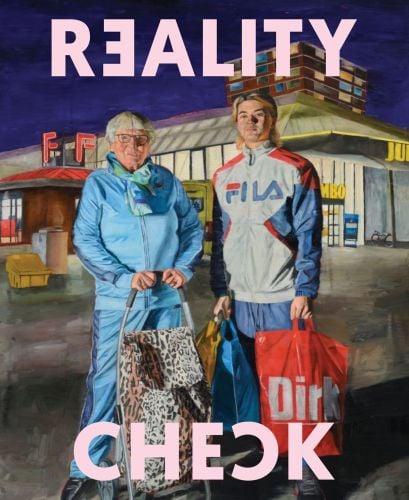

INHOUDSOPGAVE CONTENTS
TONY DOČEKAL
‘In het veld’ legt Tony Docekal (Amsterdam, 1992) mensen en gemeenschappen vast. In haar fotoserie The Color of Money and Trees zijn dat Amerikanen uit de staat Arizona, waarvan ze enkelen langdurig volgt. Tony fotografeert anoloog en grijpt zo min mogelijk in: ze legt vast wat ze tegenkomt, veelal ongeënsceneerd, ongeïdealiseerd en onbewerkt.
Realisme gaat voor Tony niet alleen over het weergeven van de zichtbare werkelijkheid, ‘maar ook over het vastleggen van een emotionele, sociale of existentiële waarheid. Het kan een manier zijn om mensen dichter bij de essentie van hun eigen ervaringen te brengen. Tegelijkertijd is het voor mij een middel om zelf verbinding te maken met de wereld om me heen en nieuwe perspectieven te ontdekken en te delen. Realisme gaat voor mij over interactie: met de mensen die ik fotografeer, met mijn eigen gevoelens en met de kijker die het werk interpreteert.’
Hoewel haar werk begint bij het documenteren van bestaande mensen en situaties, speelt Tony bewust met context en betekenis. ‘Ik wil dat mijn beelden vragen oproepen, eerder dan alleen maar iets representeren. Realisme betekent voor mij niet dat alles aan het oppervlak zichtbaar is; het gaat erom dat er een kern van waarheid of herkenbaarheid in het beeld zit die verder gaat dan het zichtbare. Het realisme biedt de mogelijkheid om onderwerpen te behandelen die op het eerste gezicht alledaags lijken, maar die een diepere gelaagdheid bevatten. Een portret van een persoon kan bijvoorbeeld zowel diens unieke persoonlijkheid laten zien als symbool staan voor een grotere maatschappelijke vraag. Deze spanning tussen het persoonlijke en het universele fascineert me en kan krachtige verhalen voortbrengen.’
Tony studeerde Fine Art aan ArtEZ in Arnhem. Solo exposeerde ze haar werk in Art Galerie O-68 in Velp en Museum Arnhem en in groepsverband op de Biënnale Vevey in Zwitserland en Museum Hilversum. In 2021 won ze de Zilveren Camera in de categorie portret. Haar werk bevindt zich in de collecties van Museum Arnhem en het Ministerie van Buitenlandse Zaken.
Tony Docekal (Amsterdam, NL, 1992) portrays people and communities ‘in the field’. In her photo series The Color of Money and Trees, she focuses on Americans from the state of Arizona, several of whom she follows for an extended period. Tony shoots in analogue with minimal intervention: she captures what she encounters; mostly unscripted, unidealised and unedited.
For Tony, realism is about more than rendering the visible reality, it is ‘also about capturing an emotional, social or existential truth. It can be a means of bringing people closer to the essence of their own experiences. And it’s also a way for me to connect with the world around me and to discover and share new perspectives. Realism is about interaction: with the people I photograph, with my own feelings and with the viewer who interprets the work.’
Although the foundations of Tony’s work involve the documentation of existing people and situations, she deliberately plays with context and meaning. ‘I want my images to raise questions, not just to represent something. For me, realism does not mean that everything is visible on the surface; there has to be an element of truth or recognisability in the image that transcends the visible. Realism makes it possible to address subjects that appear everyday at first glance, but that have greater depth. Like a portrait of a person: it can show their unique personality, and also symbolise a larger social issue. This tension between the personal and the universal fascinates me, and can create powerful stories.’
Tony studied Fine Art at ArtEZ in Arnhem. She has had solo exhibitions at Art Galerie O-68 in Velp and Museum Arnhem, and group presentations on the Biennale Vevey in Switzerland and Museum Hilversum. She won the Zilveren Camera award in 2021, in the portrait category. Tony’s work has been acquired for the collections of Museum Arnhem and the Ministry of Foreign Affairs.
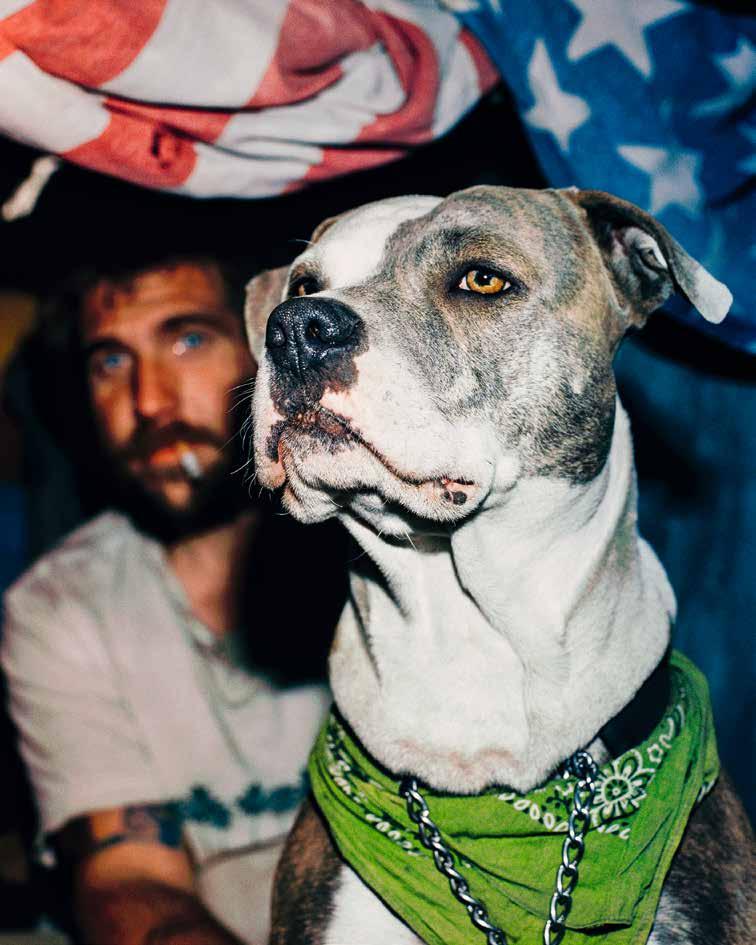
MARCO NIEMEIJER
Marco Niemeijer (Amsterdam, 1970) laat zich als maker niet voor één gat vangen. Hij heeft zijn sporen verdiend als singer-songwriter, kok, documentairemaker, regisseur en scenarist. In deze tentoonstelling is hij vertegenwoordigd met videokunst. Daarin is hij geïnteresseerd in tijd. In de wereld van vandaag, waarin men het liefst zo snel mogelijk zo veel mogelijk inhoud tot zich neemt en alle informatie bite-size moet zijn, brengt Marco videokunst die de kijker dwingt tot vertraging of stilstand en daarmee tot een andere perceptie van tijd en ruimte. Zijn onderwerpkeuze speelt daarbij een grote rol. Met veel zorg en geduld onderzoekt hij in zijn werk het ‘kleine’ onderwerp: de voorbijganger in de straat, de zorg voor een tuin, de veranderende lichtval gedurende de dag.
Al vroeg wist Marco waar hij zijn kunst op wilde laten aansluiten: ‘Op de kunstacademie had ik vaak het idee op zoek te zijn naar iets anders dan de mensen om mij heen. Zonder dit destijds te kunnen verwoorden, merkte ik dat ik in mijn beeldtaal zo dicht mogelijk wilde blijven bij “de werkelijkheid”. Inmiddels weet ik: in essentie zoek ik bij ieder werk naar de kleinst mogelijke ingrepen op wat ik zie. Hoe minder, hoe beter het werk vaak wordt. Het liefst wil ik dat je mijn interventies ook niet meer kunt aanwijzen en de kracht van het werk als het ware tussen de regels is gaan zitten.’
De werkelijkheid, erkent Marco, nemen we allemaal subjectief waar. ‘En het reële behelst in mijn definitie net zo goed het tastbare als het niet-tastbare. De uitdaging zit hem in het isoleren van iets uit al die dingen die je in één blik waarneemt, en daar een andere betekenis aan te kunnen geven, of er een andere verbinding mee te kunnen maken. In het werk HOME kijk ik vanuit een raam naar buiten, een jaar lang, één enkel raam en dat raam is je kader. Meer is er niet. Voor mij heeft het alles al in zich.’
Marco studeerde in 1998 af aan de Rietveld Academie in de richtingen Fine Arts en Audiovisueel. Als singer-songwriter bracht hij drie muziekalbums uit en in 2008 startte hij samen met zijn broer een eigen bakkerij in Amsterdam, waarvoor hij zelf de meubels en inrichting ontwierp. In 2015 startte hij als videokunstenaar en documentairemaker en schreef en regisseerde hij de documentaire Little Angels, waarmee bij de Prix Europa voor beste Europese tv-documentaire won.
Marco Niemeijer (Amsterdam, NL, 1970) is not a maker who can be easily pinned down: he has earned his stripes as a singer-songwriter, chef, documentary maker, director and screenwriter. This exhibition features Marco’s video art, in which he explores the theme of time. In the world of today, in which people strive to devour as much as possible as quickly as possible, and in which bite-sized information is the order of the day, Marco makes video art that forces the viewer to slow down or stop, and to adopt an alternative perception of time and space. His choice of subject plays a significant role. In his work, he meticulously and patiently explores the ‘small’ subject: the passer-by on the street, the care for a garden, the light changing during the day.
Marco understood the direction in which he wanted to take his art early on: ‘At the art academy, I often had the idea that I was looking for something different to those around me. I couldn’t put it into words at the time, but I realised I wanted to use a visual language that remained as close to “the reality” as possible. I now know that in each work, I’m essentially looking to interfere as little as possible with what I see. The fewer the number of alterations, the better the work often is. Ideally, the viewer cannot even identify what I’ve changed, and the power of the work lies between the lines.’
Reality, acknowledges Marco, is a subjective perception. ‘And in my definition, what is real can just as easily be the tangible as the intangible. The challenge is being able to isolate something from all the things you observe in a single glance, and to alter its meaning, or make a different connection with it. In HOME, I look out of a window, a year long. Just one window, and that window is your frame. There’s nothing else. To me, it already has everything, it doesn’t need anything else.’
Marco graduated from the Rietveld Academie in 1998, majoring in Fine Arts and Audiovisual. He has released three albums as a singer-songwriter and in 2018, he opened a bakery with his brother in Amsterdam, designing the furniture and interior himself. Marco started his career as a video artist and documentary maker in 2015. He wrote and directed the documentary Little Angels, for which he won the Prix Europa for Best European TV Documentary of the Year.
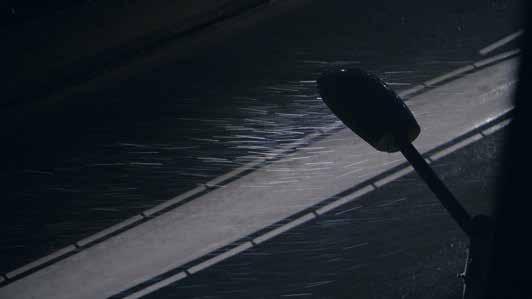
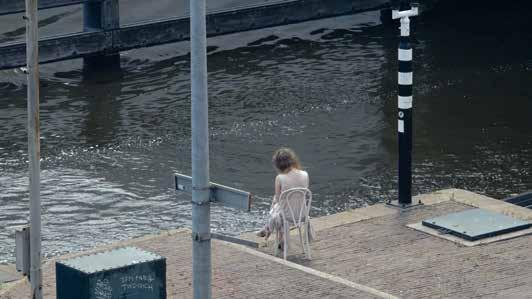
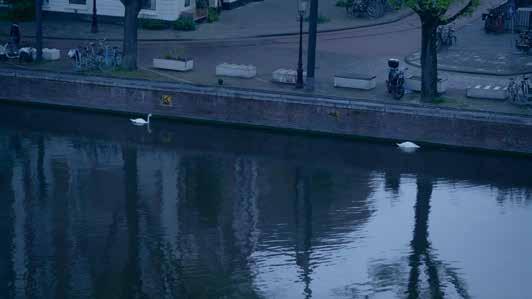
MAUDY ALFERINK
Maudy Alferink (Heeten, 1988) is een fotorealist: wie haar werk van veraf ziet, zou bijna zeker concluderen dat het gefotografeerd is. Pas van dichtbij zijn de verfstreken te zien. Om zo’n bedrieglijke echtheid te bereiken moet iemand wel professioneel zijn opgeleid, zou je zeggen. Maar Maudy leerde zichzelf het schilderen aan.
Voordat Maudy haar schildersloopbaan begon, had ze een succesvolle carrière als modestylist. Die moest ze in 2014 na een auto-ongeluk stopzetten. Met modetijdschriften als voorbeeld en inspiratie leerde ze zichzelf tijdens haar revalidatieperiode schilderen. Geheel op eigen houtje zocht ze vervolgens de juiste connecties binnen de Amerikaanse kunstmarkt. Inmiddels is haar werk te zien geweest op de kunstbeurs Art Basel in Miami en is het opgenomen in grote privéverzamelingen in binnen- en buitenland. Ook was haar werk vier jaar achtereen te zien op de Amsterdamse kunstbeurs PAN.
Net zo klip en klaar als haar beeldtaal is Maudy’s onderwerpkeuze: ze kiest overtuigd voor eigenzinnige modellen en toont ze in al hun kracht. Daarbij is ze geïnteresseerd in vrouwelijkheid, eigenheid en authenticiteit. Ook haar achtergrond in de mode is in haar werk te zien: de kleding die haar modellen dragen is vaak door haarzelf geselecteerd of zelfs ontworpen en de fotoshoots die voorafgaan aan haar schilderijen voert ze zelf uit.
Over haar schildertechniek zegt Maudy: ‘Van sieraden en metalen studs, tot haar, make-up en outfits: ik probeer altijd mijn uiterste geduld in mijn werk te leggen om alles zo realistisch mogelijk uit te werken.’ Of ze in haar onderwerpkeuze ook een realist is? ‘Ik schilder echte mensen die ik echt ontmoet in mijn leven maar die voor anderen misschien een bijna onwerkelijk leven leiden. Hun realiteit valideren is juist wat mij interesseert.’ Maudy is op zoek naar het verhaal achter haar modellen, die vaak bewust afwijken van het ‘gemiddelde’: ‘Mijn modellen hebben vaak een geheel eigen verhaal wat ook deels in hun gekozen uiterlijk zichtbaar is. Dit figuratief vastleggen geeft mij de kans om weer te geven wat mag bestaan en naar mijn idee een platform verdient. Ik oordeel daarbij niet, maar stel mezelf en mijn werk slechts open voor de mogelijke waarheden.’ Een objectieve weergave dus. Echter kan niet, toch?
Maudy Alferink (Heeten, NL, 1988) is a photorealist: if you see her work from a distance, you will almost certainly conclude that you are looking at a photograph. The brushstrokes are only visible up close. You may think that such deceptive authenticity could only come from professional training. But you’d be wrong: Maudy is autodidactic.
Before Maudy became a painter, she was a successful fashion stylist. This career was cut short in 2014 following a car accident. While she recovered, she taught herself to paint, using fashion magazines as examples and for inspiration. Completely under her own steam, Maudy subsequently set about finding the right connections in the American art market. Her work has since featured in the Art Basel fair in Miami, and has been acquired for major private collections in the Netherlands and abroad. It was also displayed at the Amsterdam PAN art fair in four consecutive years.
The clarity in Maudy’s visual language is also reflected in her choice of subject: she confidently chooses distinctive models, who she allows to shine. Maudy focuses on femininity, individuality and authenticity. Her background in fashion is also evident in her work: she often selects (and even designs) the clothes worn by the models, and she is behind the camera for the photo shoots that precede her paintings.
Commenting on her painting technique, Maudy says: ‘From jewellery to metal studs, to hair, make-up and outfits: I always try to bring my utmost patience to my work, to make everything as realistic as possible.’ Whether she’s also a realist when it comes to her choice of subject? ‘I paint real people, who I really meet. To others, they may lead almost unreal lives. Validating their reality is precisely what intrigues me.’ Maudy seeks the story behind her models, who often deliberately deviate from the ‘standard’: ‘My models often have a highly individual story, which is partly reflected in how they choose to look. Capturing this figuratively gives me the opportunity to depict that which has a right to exist, and that I think deserves a platform. I don’t judge, I just open myself and my work to potential truths.’ Hence, an objective portrayal. You can’t get more real than that, right?
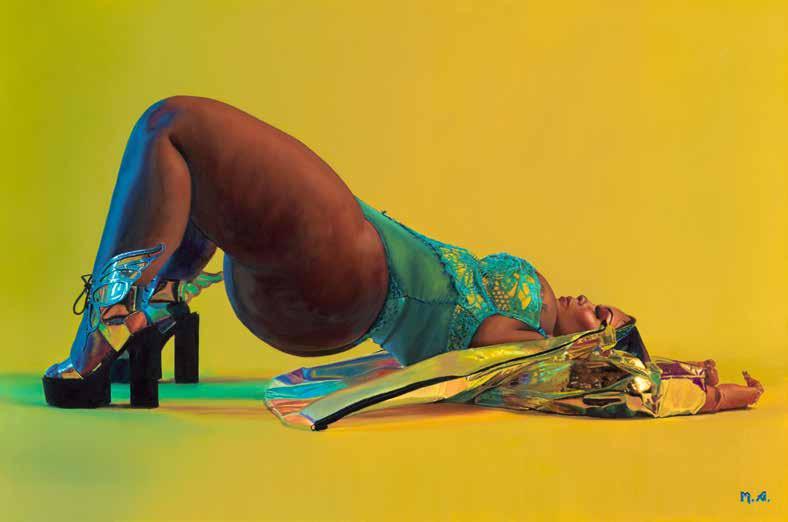
ANYA JANSSEN
‘Schilderen is voor mij de ultieme poging om dichter bij mensen te komen’, zegt Anya Janssen (Nijmegen, 1962) zelf over haar werk. En dichtbij komen doet ze. Vaak schildert ze mensen zoals ze niet vaak in het openbaar te zien zijn: kwetsbaar, (half)naakt of in omhelzingen verstrengeld. Vaak ook zijn in haar werk mensen uit subculturen te zien: ravers, punkers, gabbers. De werelden van haar modellen zijn inspiratiebronnen voor Anya, maar ze laat zich net zo goed inspireren door de Vlaamse primitieven.
Hoewel Anya’s werk in kleurgebruik nogal eens afwijkt van de realiteit, zijn haar mensfiguren in elk ander opzicht levensecht geschilderd. Toch noemt ze zichzelf niet meteen een realist: ‘Ik ben geen realist zoals in de Van Dale beschreven wordt: iemand die de werkelijkheid wil weergeven volgens objectieve waarneming. Ik ben nooit geïnteresseerd geweest in het afbeelden van de werkelijkheid op zichzelf, maar eerder in hoe die wordt waargenomen. In mijn werk zoek ik naar de grenzen tussen illusie en werkelijkheid om te raken aan de onkenbare wereld die schuilgaat achter het zintuiglijk waarneembare.’
De figuratieve beeldtaal gebruikt Anya heel bewust: ‘Die werkt voor mij het beste om in dialoog te komen met de personen of onderwerpen die ik schilder. Tijdens het schilderen stel ik de vraag waar de mensheid en menselijkheid begint en waar ze ophoudt. Wat is onze plaats op deze planeet? Hoe leven we ons leven? Wat mij interesseert, is het spel van impliciete toespelingen. Wat niet op het doek staat, is voor mij wezenlijker dan wat er wel staat. Ik gebruik schoonheid en een zekere mate van realisme om mensen naar mijn werk te lokken. Ik verleid de toeschouwers, zodat ze willen kijken. En daarna wil ik dat ze ook iets zien en voelen. Eerst verleiden, dan confronteren.’
Uiteindelijk gaat het Anya in haar werk ook zeker om de verwijzing naar ‘het echte leven’, naar de realiteit: ‘Levend en levenloos, goed en kwaad, bloei en verval gaan hand in hand in mijn werk, zoals in het echte leven. Francis Bacon zei het zo prachtig: “You can never be cruel in abstract paintings”.’
Anya studeerde aan de ArtEZ in Arnhem, waar ze sinds 2004 Fine Art en Fashion Design doceert. Ze heeft vele solotentoonstellingen op haar naam staan, waaronder in 2022 bij Museum MORE. Haar werk bevindt zich onder andere in de collecties van ABN Amro, Museum Arnhem, Teylers Museum en Museum MORE.
‘For me, painting is a fundamental effort to get closer to people’, says Anya Janssen (Nijmegen, NL, 1962) about her work. And she certainly gets close. Anya often paints people as they are not usually seen in public: vulnerable, (semi)nude, or entwined in an embrace. Her work commonly features people from subcultures: clubbers, punkers, ravers. She is inspired by her models’ worlds, but just as readily draws inspiration from the Flemish Primitives.
Anya’s colours deviate notably from reality, but all other aspects of her human figures are painted true to life. And yet she would not immediately call herself a realist: ‘I’m not a realist in the dictionary sense of the word: someone who sets out to render reality according to objective observation. I have never been interested in depicting it alone, but rather in how it is perceived. In my work, I seek the boundaries between illusion and reality, in order to touch upon the unknowable world that lays beyond that which is perceptible to the senses.’
Anya’s use of figurative visual language is highly deliberate: ‘That is the best way for me to engage with the people or subjects in my paintings. While painting, I ask myself where humankind and humanity begins, and where it ends. What are we doing here, on this planet? How do we live our lives? I’m intrigued by the play of implicit allusions. What is not on the canvas is more real to me than what is. I use beauty and a certain degree of realism to draw people towards my work. I tempt viewers into looking. And then I want them to also see and feel something. First I tempt, then I confront.’
The artist is ultimately also keen to reference ‘real life’, reality: ‘In my work, living and lifeless, good and evil, florescence and decay go hand in hand, like in real life. Francis Bacon put it beautifully: “You can never be cruel in abstract paintings”.’
Anya studied at ArtEZ in Arnhem, and has taught Fine Art and Fashion Design at the institution since 2004. She has had a number of solo exhibitions, including at Museum MORE in 2022. Her work has been acquired for numerous collections, including those of ABN Amro, Museum Arnhem, Teylers Museum and Museum MORE.
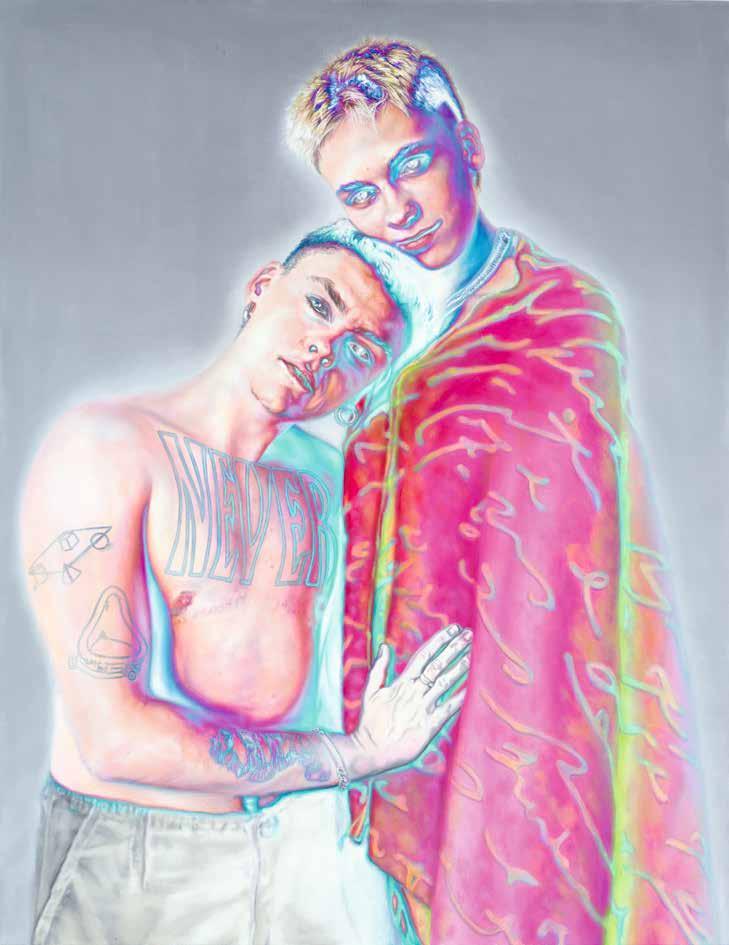
artist’s collection
KAILI SMITH
Het werk van Kaili Smith (Amsterdam, 1995) is hoogstpersoonlijk en tegelijkertijd bevat het iets universeels. Vanuit een interesse voor menselijk gedrag onderzoekt Kaili in zijn werk thema’s als vluchtelingenproblematiek, menselijke relaties en jeugdcultuur. Hij put uit zijn eigen leven: familieleden, vrienden en mensen uit de buurt staan model en worden ongeïdealiseerd weergegeven.
Hoewel Kaili’s beeldtaal overtuigend figuratief is, ziet hij zichzelf steeds minder als realist. ‘Misschien ben ik een realist om vanuit dat perspectief de wereld om me heen te doorgronden en verkennen, maar het hele doel van mijn werk is om dat wat is, te transformeren tot dat wat zou kunnen zijn. Deze methode vormt de basis van al mijn stijlen en projecten. In de afgelopen tien jaar als schilder lijkt elke nieuwe serie werken die ik maak te schommelen tussen een meer formeel realisme en een stijl beïnvloed door abstractie en soms surrealisme. Op dit moment werk ik aan mijn meest surrealistische schilderijen tot nu toe, terwijl mijn vorige serie An Ode To Noord and Family mijn meest realistische serie was, zowel qua methode als concept.’
In alles wat hij maakt, is de menselijke psychologie het belangrijkste onderwerp. ‘Ik verwacht niet dat ik de eigenaardigheid van de mens ooit zal doorgronden, dus er zal altijd iets of iemand zijn om te schilderen.’ De figuratie blijft daarom in Kaili’s werk belangrijk. Die stelt hem in staat de mens op steeds andere manieren te onderzoeken. ‘Dat ik mijn hele leven in steden heb gewoond verklaart waarschijnlijk waarom mijn werken altijd mensen bevatten. Het is niet dat ik geen interesse heb in andere onderwerpen, maar ik denk dat het belangrijk is om als kunstenaar te bepalen wat je precies wilt communiceren in je werk, en daar je focus op te leggen. Voor mij zijn dat de verhalen van de mensen om me heen.’
Kaili werd geboren in Nederland, maar groeide op in Australië. Hij studeerde aan de Willem de Kooning Academie in Rotterdam, gevolgd door een master aan de Parsons New School in New York. Sinds zijn studie woont en werkt hij afwisselend in Amsterdam en New York. Zijn werk was te zien in tentoonstellingen in de Verenigde Staten, het Verenigd Koninkrijk en Nederland. In 2021 en 2023 was hij genomineerd voor de Koninklijke Prijs voor Vrije Schilderkunst, waarbij hij in 2021 de publieksprijs won. Sinds 2023 studeert hij aan de Rijksakademie in Amsterdam.
The work of Kaili Smith (Amsterdam, NL, 1995) is highly personal, yet it is also imbued with a sense of the universal. The artist is intrigued by human behaviour, and uses his work to explore themes including human relationships, youth culture and issues involving asylum seekers. He draws inspiration from his own life: family members, friends and neighbours are his models, portrayed in an unidealised fashion.
Kaili’s visual language is certainly figurative, but he sees himself less and less as a realist. ‘I’m maybe a realist as a starting point to understanding and informing myself about the world around me, but my entire aim with my work is to take what is, and turn it into what could be. This method has informed all the styles and projects that I’ve ever worked on. During the past decade as a painter, each new series of works I make seems to bounce back and forth between a more formal realism and one influenced by abstraction and at times surrealism. I’m currently working on my most surrealistic paintings to date, whereas my past series An Ode To Noord and Family was my most realistic series to date, both in terms of method and concept.’
Human psychology is the most important subject in everything that Kaili makes. ‘I don’t ever see myself figuring out the strangeness of the human condition, so there will always be something or someone to paint.’ Figuration therefore remains an important aspect in Kaili’s work. It means that he always has new ways of exploring people. ‘Having lived in cities throughout my life probably explains why my works always have people in them, it’s not that I’m not interested in other subjects. But I think as an artist, it is important to decide what the most important thing is that you want to communicate in this world, and to focus on that. For me, that’s the stories of the people around me.’
Kaili was born in the Netherlands, and grew up in Australia. He studied at the Willem de Kooning Academie in Rotterdam, before taking his Master’s at the Parsons New School in New York. The artist now divides his time between Amsterdam and New York. Kaili’s work has featured in exhibitions in the United States, the United Kingdom and the Netherlands. He was nominated for the Royal Award for Modern Painting in 2021 and 2023, winning the audience award in 2021. Kaili started a new study at the Rijksakademie in Amsterdam in 2023.
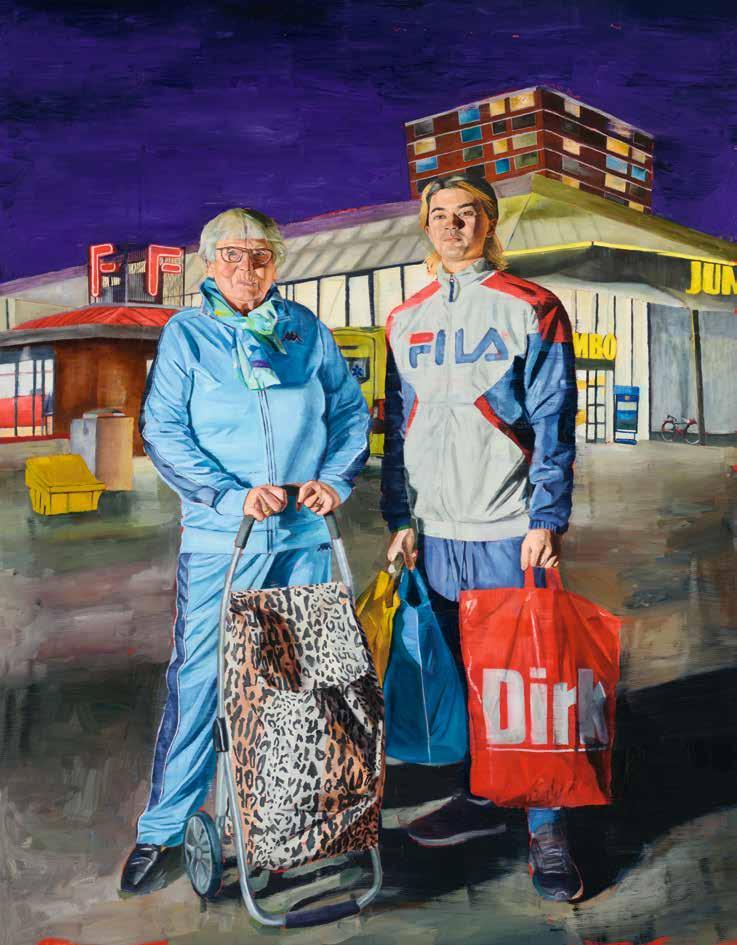
ARJAN VAN HELMOND
Arjan van Helmond (Deurne, 1971) is geïnteresseerd in het alledaagse: het tapijt onder onze voeten, de kleur van het behang, souvenirs en prullaria in de kast. ‘Ik beschouw mijn werk als een onvoltooide, gefragmenteerde inventaris en een kritische analyse van onze alledaagse omgeving. Door de aandacht voor deze details wordt een spanning zichtbaar tussen dagelijkse gewoonten en culturele en historische aspecten. Wat betekenen die ruimtes en die objecten om ons heen? Wat vertellen ze ons?’
Arjan maakt voor zijn werk vaak gebruik van foto’s, maar is niet op zoek naar een fotografische weergave. Het draait bij hem om het gevoel: die plotselinge herinnering of de vlaag van nostalgie die alledaagse taferelen kunnen oproepen.
Arjan ziet zichzelf niet als realist. ‘Eerlijk gezegd is die vraag niet zo relevant voor me. Waar het me om gaat is het opbouwen van de onderhuidse spanning in het schilderij, iets voelbaar maken wat niet per se zichtbaar is. Een realistische weergave van de ruimtes en objecten die ik schilder, helpt me om in een bepaalde focus te komen, om een specifieke aandacht te genereren. Door het heen en weer schakelen tussen foto en schilderij ontstaat een ritme, dat voor mij de verbeelding op gang helpt. Uiteindelijk vindt een schilderij zijn oplossing, zijn vraag of juist zijn conclusie in de verf, in het proces van schilderen, en niet zozeer in het realistische effect ervan.’
De figuratie heeft Arjans interesse omdat die meer mogelijkheden biedt om te bereiken wat hij wil. Maar er is volgens hem geen figuratie zonder abstractie: ‘Eigenlijk is er geen scheiding. Om een overtuigend en realistisch figuratief beeld te creëren, moet je enorm veel abstracte beslissingen nemen. Alleen een plaatje maken is niet voldoende, er moet meer gebeuren. Door het proberen, mislukken, weer weghalen, stukken toevoegen, kijken en opnieuw proberen eigen je je een beeld langzaam toe. Ik denk dat het juist dat aspect is, dat die figuratieve beeldtaal zo aantrekkelijk maakt voor mij: juist de problemen en moeilijkheden die het veroorzaakt.’
Arjan studeerde aan de Rijksakademie, woont en werkt in Amsterdam en exposeert in binnen- en buitenland, waaronder in 2022 in Museum MORE. In 2017 ontving hij de Jeanne Oosting Prijs voor zijn oeuvre tot dan toe.
Arjan van Helmond (Deurne, NL, 1971) is intrigued by the commonplace: the carpet under our feet, the colour of the wallpaper, souvenirs and knick-knacks in the cabinet. ‘I see my work as an unfinished, fragmented inventory and a critical analysis of our everyday environment. Focusing on these details reveals a tension between daily rituals and cultural and historical aspects. What do the spaces and objects around us mean? What do they tell us?’
Arjan often works using photographs, but is not aiming for a photographic portrayal. It is all about the feeling: that sudden memory, or the surge of nostalgia that everyday scenes can evoke.
The artist does not consider himself a realist. ‘To be honest, the question is not that relevant to me. It’s about building the subdued tension in the painting, adding tangibility to something that is not necessarily visible. A realistic portrayal of the spaces and objects that I paint helps me to achieve a certain focus, to create a specific awareness. Switching back and forth between photograph and painting creates a rhythm, which helps ignite my imagination. A painting ultimately finds its solution, its question or its conclusion in the paint, in the process of painting, rather than in its realistic effect.’
Arjan is drawn to figuration because it offers him more ways of achieving his goal. But, he says, figuration cannot exist without abstraction. ‘There’s actually no distinction. To create a convincing and realistic figurative image, you have to make an enormous number of abstract decisions. Just making a picture is not enough, more has to happen. By trying, failing, removing and adding bits, looking and trying again, you gradually lay claim to an image. It’s precisely this aspect that makes the figurative visual language so attractive to me: the problems and difficulties that it causes.’
Arjan studied at the Rijksakademie, lives and works in Amsterdam, and exhibits both in the Netherlands and abroad, including at Museum MORE in 2022. In 2017, he received the Jeanne Oosting Award for his oeuvre to date.
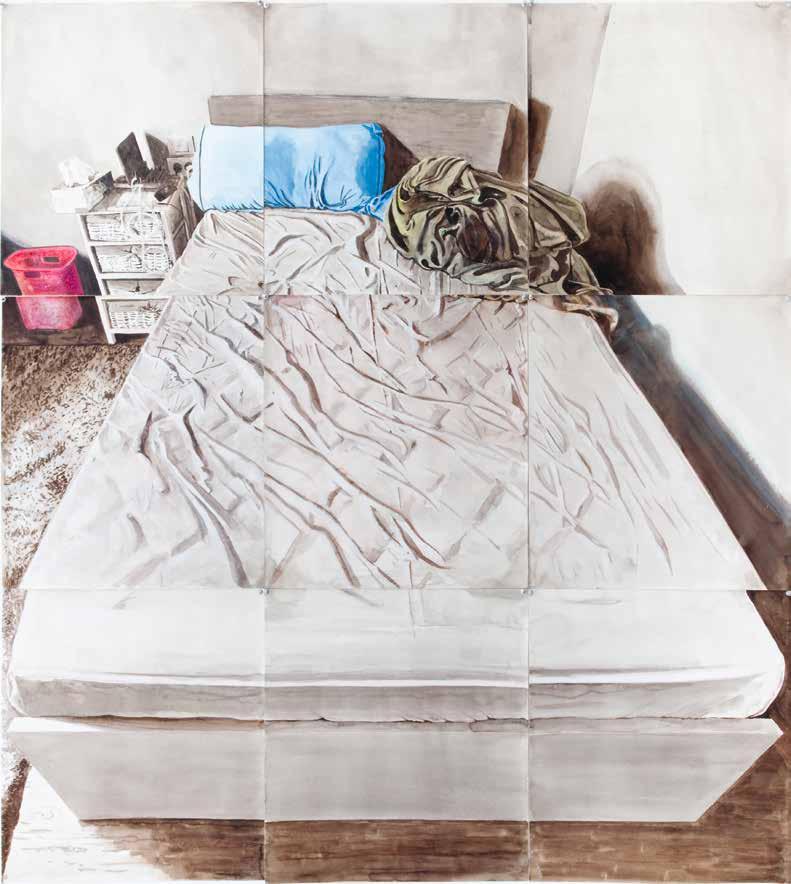
ANNA REERDS
Een wereld die tegelijkertijd herkenbaar en vervreemdend is, dat is de wereld van Anna Reerds (Alkmaar, 1996). In haar werk zet Anna de schijnwerper op het alledaagse: snackbars, flatgebouwen en wasserettes vormen de plaats van handeling. Op het eerste gezicht gebeurt er niet veel: iemand drinkt koffie, de wasmachines draaien. Anna toont de triviale wereld die we allemaal delen met aandacht voor het kleine en liefde voor het menselijke gedrag. Ze gebruikt fotografie, schaalmodellen, film en animatie in haar werk, waarbij het vaak niet duidelijk is welk onderdeel precies op welke manier is vormgegeven.
Doordat Anna in zo veel verschillende media werkt, dacht ze nooit zo na over de vraag of haar werk in het realisme paste. ‘Ik werk in andere media dan de realisten zoals ik ze ken, die vaak binnen de schilderkunst opereren. Maar omdat ik me in mijn werk bezighoud met het verbeelden van alledaagse onderwerpen die herkenbaar zijn voor de kijker, zou je zeker kunnen zeggen dat ik realist ben. Met misschien hier en daar een beetje magisch realisme.’ De herkenbaarheid van de figuratie is voor Anna belangrijk: ‘Mijn beeldtaal voelt als een logische voortvloeiing uit de thema’s die in mijn werk een rol spelen. Ik wil dat de kijker het beeld dat ik creëer herkent als een mogelijke, maar niet altijd waarschijnlijke werkelijkheid. Ook al zijn de plekken die ik verbeeld non-existent –het zijn beeldende samenstellingen, bewerkingen en reconstructies van de werkelijkheid – de kijker kan zich tot het werk verhouden en zich er in gedachten doorheen bewegen.’
Anna studeerde Product Design aan de HKU, waar ze sinds 2020 ook doceert. Haar werk werd onder meer getoond in Kunsthal Kloof, Moving Gallery en Logman Gallery, alle in haar woon- en werkplaats Utrecht. Naast autonoom werk maakt Anna ook illustraties – onder meer bij artikelen in De Volkskrant en De Correspondent – en maakte ze sets voor de korte film Een hond die huilt.
A world that is both recognisable and alienating, that is the world of Anna Reerds (Alkmaar, NL, 1996). Anna spotlights the everyday in her work: snack bars, flats and launderettes are her settings. On the face of it, little appears to be happening: someone drinks coffee, the washing machines spin. Anna shows our trivial world with a focus on the seemingly insignificant and a love of human behaviour. She uses photography, scale models, film and animation in her work, and it is often unclear which medium is used for which part.
Because Anna works in so many different mediums, she had never considered whether her work qualifies as realism. ‘I use different mediums to the realists as I know them, who often paint. But in my work, I depict everyday subjects that are recognisable to the viewer, so you could certainly say that I’m a realist. With a touch of magic realism here and there.’ The recognisability of figuration is important to Anna: ‘My visual language feels like it stems naturally from the themes that play a role in my work. I want the viewer to recognise the image that I create as a possible, but not always probable, reality. The places in my works may be non-existent – they are visual compositions, adaptations and reconstructions of reality –, but the viewer is still able to relate to the work and imagine moving through it.’
Anna studied Product Design at the HKU, where she became a teacher in 2020. Her work has been exhibited at Kunsthal Kloof, Moving Gallery and Logman Gallery, all located in Utrecht, where she lives and works. Alongside independent work, Anna makes illustrations – including for articles in De Volkskrant and De Correspondent – and she also made the sets for the short film Een hond die huilt (A Dog that Howls).




CAJA BOOGERS
Het werk van Caja Boogers (Vlaardingen, 2001) is gelaagd in meerdere betekenissen van het woord. Met modelleerpasta brengt hij een grondlaag aan op zijn doeken, waarbij hij imperfecties toelaat en geregeld ook in de pasta krast. Daaroverheen legt hij zijn voorstellingen, die nogal variëren in onderwerp. In zijn nog jonge oeuvre bewoog hij van het afbeelden van bijna abstracte ijsoppervlakten naar kopieën van oude familiefoto’s. Altijd pendelt zijn werk tussen de voorstelling en de voorstellingloosheid, tussen kijken, begrijpen, weten en verwonderen. Door zijn motief veelvoudig te herhalen, probeert hij grip te krijgen op onderwerpen die zich moeilijk laten fixeren.
Caja ervaart het realisme niet als dwingend: ‘Ik zie realistische schilderkunst als een element dat ik kan inzetten wanneer ik het bruikbaar vind. Ik denk dat schilderkunst in het algemeen een idee of een onderwerp op zo’n manier kan isoleren en verheffen dat het de toeschouwer kan prikkelen, en een gevoel van herkenning kan geven. Die herkenning vind ik spannend. De geschilderde realiteit dwingt de kijker soms om anders te kijken naar dé realiteit, en er langer bij stil te staan. Dit principe, van iets herkennen en ergens de tijd voor nemen, is een waardevol gegeven.’
Het gebruik van realisme en figuratie is voor Caja iets natuurlijks: ‘Dit heeft onvermijdelijk te maken met de snelle digitale beeldcultuur waar we dagelijks aan worden blootgesteld. Je ziet wel honderden beelden op een dag.’
Op zijn telefoon heeft Caja een beeldbank aangelegd van beelden die hij visueel interessant vindt: van screenshots en foto’s van schilderijen tot beelden uit fotoalbums en historische foto’s. ‘Wanneer ik in mijn atelier ben, scrol ik weleens door dit album. Het is dan alsof ik een geëxternaliseerd deel van mijn eigen hoofd bekijk. Het zijn ook meestal beelden uit dit album die ik gebruik als bronmateriaal bij het schilderen.’
Caja studeerde in 2023 af aan de HKU. Nadien toonde hij solo bij Galerie Gerhard Hofland en was hij onderdeel van groepstentoonstellingen in Museum Helmond en Galerie Ron Mandos. Zijn werk is onder meer onderdeel van de collecties van Museum Voorlinden, het Ministerie van Buitenlandse Zaken, de Lakeside Collection, AkzoNobel en de ING. In 2023 won hij de Lakeside Collection Award, wat hem een residentie van een jaar in het Depot van Museum Boijmans Van Beuningen opleverde.
The work of Caja Boogers (Vlaardingen, NL, 2001) is layered in numerous senses of the word. He applies a ground of modelling paste to his canvases, accepting imperfections and often even scratching the paste. His pictures, which have a wide variety of subjects, are applied on top. In Caja’s still young oeuvre, he moved from rendering almost abstract expanses of ice to copies of old family photographs. His work always switches between the image and the absence of imagery, between looking, understanding, knowing and admiring. By repeating his motif many times, he attempts to grasp subjects that are difficult to pin down.
Caja doesn’t see realism as a necessity: ‘Realistic painting is an element that I can use when I think it is appropriate. Painting in general can isolate and elevate an idea or subject in such a way that it can stimulate the viewer, give a sense of recognition. This recognition excites me. The painted reality sometimes forces the viewer to look differently at reality, to linger on it for longer. This principle, of recognising something and taking time for something, is valuable.’
Using realism and figuration feels natural to Caja: ‘This inevitably comes down to the rapid digital visual culture to which we are exposed on a daily basis. You see hundreds of images every day.’ Caja has an image bank on his telephone, to store images that visually interest him: from screenshots and photographs of paintings to images from photo albums and historical photographs. ‘I sometimes scroll through this album when I’m in my studio. It’s like looking at an externalised part of my own head. It’s usually images from this album that I use as source material for my paintings.’
Caja graduated from the HKU in 2023. He has since had a solo exhibition at Galerie Gerhard Hofland, and was involved with group exhibitions at Museum Helmond and Galerie Ron Mandos. His work has been acquired for the collections of Museum Voorlinden, the Ministry of Foreign Affairs, the Lakeside Collection, AkzoNobel and ING. In 2023, he won the Lakeside Collection Award, earning him a twelve-month residency at the Depot of Museum Boijmans Van Beuningen.
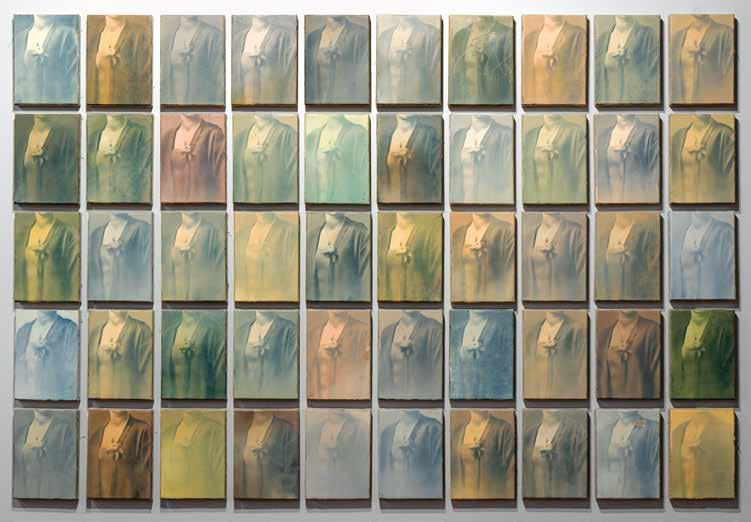
Voorlinden, Wassenaar
ROBIN SPEIJER
Robin Speijer (Hilversum, 1997) onderzoekt in haar werk de diffuse gebieden tussen de figuratie en de abstractie, tussen vorm en voorstelling. In vele verschillende verschijningsvormen toont ze steeds weer hoe dat schemergebied eruit kan zien: vormen, lijnen, patronen en kleuren bestaan in haar werk in harmonie met wat afgebeeld is. Dat is altijd een variant van hetzelfde: een stuk textiel. ‘Textiel kan een oneindig aantal vormen aannemen, terwijl het herkenbaar blijft als een zacht en flexibel materiaal.’
De kadrering van haar schilderijen is voor Robin belangrijk: door alleen close-ups te gebruiken en de grenzen van de lap stof buiten beeld te laten, ontneemt ze de kijker de context, waardoor de focus onvermijdelijk op het oppervlak komt te liggen. Daarnaast speelt het formaat van haar werk een grote rol in de beleving: het textiel wordt in Robins handen monumentaal.
Robin gebruikt realistische elementen om bepaalde effecten te bereiken: ‘Beeldelementen zoals licht, schaduw en perspectief zijn direct herkenbaar en maken het werk daardoor visueel toegankelijk. In een schilderij geven deze elementen daarnaast de illusie van ruimtelijkheid: de verf lijkt het platte vlak te ontstijgen. Tegelijkertijd ben ik uit op vervreemding van de werkelijkheid. Door een uitsnede te maken en hierop in te zoomen beschik je als kijker over beperkte informatie. Van een afstand lijkt mijn werk nauwkeurig geschilderd en haast echt, maar niets is minder waar. Van dichtbij zie je zachte massa’s van kleur en losse kwaststreken. De composities hebben een onnatuurlijk oogpunt en zijn sterk uitvergroot. Hierdoor zijn er andere interpretaties mogelijk dan enkel het beeld uit de werkelijkheid dat als startpunt fungeerde.’ Robin wil per se voorkomen dat het werk eenduidig is: ‘Juist het grijze gebied dat tussen figuratie en abstractie leeft is wat me blijft fascineren in het maken.’
Robin studeerde in 2019 cum laude af aan de HKU in Utrecht en nam deel aan groepstentoonstellingen in onder meer Museum MORE, Museum Belvédère en Stedelijk Museum Schiedam. In 2019 won zij het felbegeerde Dooyewaard Stipendium en in 2020 de Sacha Tanja Penning: een belangrijke prijs voor kunstenaars binnen het realisme. Robins werk bevindt zich in de collecties van Museum Voorlinden en Stedelijk Museum Schiedam.
Robin Speijer (Hilversum, NL, 1997) uses her work to explore the blurry boundaries between figuration and abstraction, between form and image. Using a wide range of manifestations, she reveals how this grey area could look: in her work, shapes, lines, patterns and colours exist in harmony with what is depicted. That is always a variant of the same thing: a piece of fabric. ‘Textiles can assume an endless number of forms, while remaining recognisable as a soft and flexible material.’
The framing of Robin’s paintings is an important aspect to her: by only using close-ups and leaving the edges of the piece of fabric out of view, she deprives the viewer of context, placing the focus inevitably on the surface. The size of her work also has a significant impact on the experience: in Robin’s hands, textiles become monumental.
Robin uses realistic elements to achieve certain effects: ‘Image elements such as light, shadow and perspective are immediately recognisable and therefore make the work visually accessible. In a painting, these elements also give the illusion of space: the paint appears to rise up from the flat surface. But I also want to achieve an estrangement from reality. Zooming in on a crop means that the viewer has limited information. From a distance, my work seems meticulously painted and almost real, but nothing is further from the truth. Close up, you see swathes of colour and loose brushstrokes. The compositions have an unnatural perspective, and are heavily magnified. This allows for alternative interpretations than simply the image from reality that was the starting point.’ Robin wants to avoid unambiguity at all costs: ‘It’s precisely the grey area between figuration and abstraction that continues to fascinate me when making art.’
Robin graduated with honours from the HKU (Utrecht) in 2019, and has been part of group exhibitions at institutions including Museum MORE, Museum Belvédère and the Stedelijk Museum Schiedam. In 2019, she won the highly coveted Dooyewaard Stipendium, followed in 2020 by the Sacha Tanja Penning: an important award for artists in the field of realism. Robin’s work has been acquired for the collections of Museum Voorlinden and the Stedelijk Museum Schiedam.
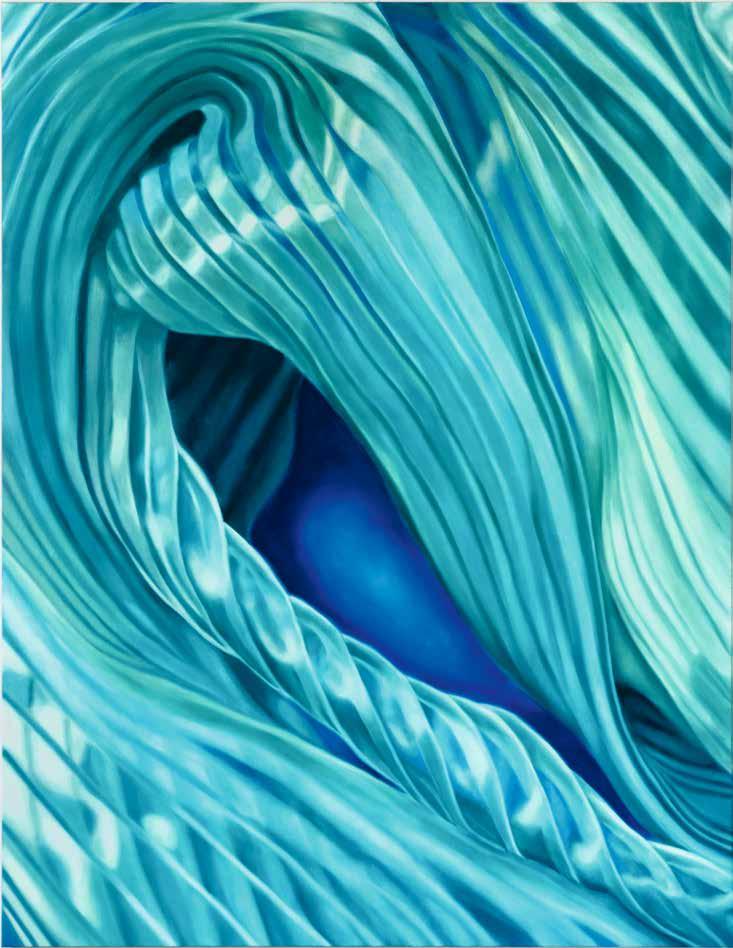
Susurrus 2023
olieverf op doek | oil on canvas |
220 x 170 cm
collectie
kunstenaar | artist’s collection
COLOFON CREDITS
Reality Check | 1O jaar MORE, 1O jaar realisme verschijnt bij de gelijknamige tentoonstelling in Museum MORE in Gorssel, van 16 februari tot 9 juni 2025.
Reality Check | 1O years of MORE, 1O years of realism accompanies the exhibition of the same name in Museum MORE in Gorssel, from February 16th to June 9th 2025.
Uitgave | Publisher
Waanders Uitgevers, Zwolle www.waanders.nl Museum MORE info@museummore.nl www.museummore.nl
Tekst en samenstelling | Text and compilation
Sito Rozema
Eindredactie | Final editing
Marleen Blokhuis
Grafisch ontwerp | Graphic design
Dana Dijkgraaf Design
Vertalingen | Translations
Dave Nice (NL-EN)
Betty Klaasse (EN-NL)
Lithografie | Lithography
Benno Slijkhuis, Wilco Arts Books
Druk | Print
Wilco Art Books, Amersfoort
Fotoverantwoording | Photo credits
Alle foto’s zijn gemaakt door de kunstenaars, met uitzondering van: All photos were taken by the artists, except:
Raafat Ballan (p.53): Sophie Steengracht
Caja Boogers (p.129), Bo Bosk (p.55) en Dion Rosina (p.79): Jonathan de Waart
Eline Brontsema (p.97): Art Revisited Gustave Courbet (p.7): Photo Scala, Florence/bpk, Bildagentur für Kunst, Kultur und Geschichte, Berlin
Jasper Hagenaar (p.87, 89-91): Lotte van Stekelenburg
David Haines (p.125-127) en Ronald
Ophuis (p.21, 38): Gert Jan van Rooij
Lieven Hendriks (p.131): Koen Kievits
Merel Jansen (p.61): Sifra Kock
Lynne Leegte (p.107): Roderik Henderson
Wolfgang Messing (p.10, 33-35): Maarten Kools
Kaili Smith (p.81, cover): Peter Cox
© 2025 Waanders Uitgevers, Zwolle | Museum MORE
Alle rechten voorbehouden. Niets uit deze uitgave mag worden verveelvoudigd, opgeslagen in een geautomatiseerd gegevensbestand, of openbaar gemaakt, in enige vorm of op enige wijze, hetzij elektronisch, mechanisch, door fotokopieën, opnamen of op enige andere wijze, zonder voorafgaande schriftelijke toestemming van de uitgever. All rights reserved. Nothing from this publication may be reproduced, multiplied, stored in an electronic data file, or made public in any form or any manner, be it electronic, mechanical, through photocopying, recording or in any other way, without the advance written permission of the publisher.
De uitgever heeft ernaar gestreefd de rechten van de illustraties volgens wettelijke bepalingen te regelen. Degenen die desondanks menen zekere rechten te kunnen doen gelden, kunnen zich alsnog tot de uitgever wenden. The publisher has made every effort to acknowledge the copyright of works illustrated in this book.
Should any person, despite this, feel that an omission has been made, they are requested to inform the publisher of this fact.
Van werken van beeldend kunstenaars aangesloten bij een CISAC-organisatie is het auteursrecht geregeld met Pictoright te Amsterdam © c/o Pictoright Amsterdam 2025. Copyright on works by visual artists affiliated to a CISAC organization is arranged with Pictoright in Amsterdam. © c/o Pictoright Amsterdam 2025. Kira Fröse, Arjan van Helmond, Anya Janssen, Maja Klaassens, Katrin Korfmann, Marjolein Rothman en Robin Speijer © c/o Pictoright Amsterdam 2025.
ISBN 9789462626140 NUR 644
